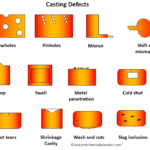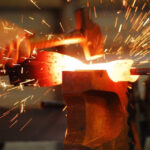Definition
The temperature of the metal at which it changes its phase from solid-state to liquid state is called its melting point. At the melting point, the solid and liquid state of the metal exists in equilibrium. The melting temperature of metal tells us that it will liquefy at that point. For changing the shape of the metals and transform it into new parts, it is melted.
The knowledge of the melting temperature of metals is very crucial in the manufacturing industries. It gives us an idea about how to handle that metal more effectively for the casting process.

Factors Affecting the Melting Points of Metals
The Force of Attraction:
The melting point is directly proportional to the force of attraction. It means that if the metal has a greater force of attraction between the atoms, its melting point will be higher. And metal with lower force of attraction has lower melting point temperatures.
Impurities
Impurities present in any metals elevates its melting point. A pure metal free from impurities has low melting points as compared with that metal having impurities in it.
Here is the Chart of melting points of metals in degree celsius and Fahrenheit Scale
S.no | Name of Metals | Melting Point (In Degree Fahrenheit) °F | Melting Point (In Degree Celsius) °C |
| 1. | Admiralty Brass | 1650-1720 | 900-940 |
| 2. | Aluminium | 1220 | 660 |
| 3. | Aluminum Alloys | 865-1240 | 463-671 |
| 4. | Aluminum Bronze | 1190-1215 | 600-655 |
| 5. | Babbitt | 480 | 249 |
| 6. | Beryllium | 2345 | 1285 |
| 7. | Beryllium Copper | 1587-1750 | 865-955 |
| 8. | Bismuth | 521 | 272 |
| 9. | Brass, Red | 1810-1880 | 990-1025 |
| 10. | Brass, Yellow | 1660-1710 | 905-932 |
| 11. | Bronze | 1675 | 913 |
| 12. | Cadmium | 610 | 321 |
| 13. | Chromium | 3380 | 1860 |
| 14. | Cobalt | 2723 | 1495 |
| 15. | Copper | 1983 | 1084 |
| 16. | Gold | 1945 | 1063 |
| 17. | Hastelloy | 2410-2460 | 1320-1350 |
| 18. | Inconel | 2540-2600 | 1390-1425 |
| 19. | Incoloy | 2540-2600 | 1390-1425 |
| 20. | Iron, Wrought | 2700-2900 | 1482-1593 |
| 21. | Iron, Cast | 2060-2200 | 1127-1204 |
| 22. | Iron, Ductile | 2100 | 1149 |
| 23. | Lead | 621 | 328 |
| 24. | Magnesium | 1200 | 650 |
| 25. | Magnesium Alloys | 660-1200 | 349-649 |
| 26. | Manganese | 2271 | 1244 |
| 27. | Manganese Bronze | 1590-1630 | 865-890 |
| 28. | Mercury | -38 | -39 |
| 29. | Molybdenum | 4750 | 2620 |
| 30. | Monel | 2370-2460 | 1300-1350 |
| 31. | Nickel | 2647 | 1453 |
| 32. | Niobium (Columbium) | 4473 | 2470 |
| 33. | Palladium | 2831 | 1555 |
| 34. | Phosphorus | 111 | 44 |
| 35. | Platinum | 3220 | 1770 |
| 36. | Rhenium | 5767 | 3186 |
| 37. | Rhodium | 3569 | 1965 |
| 38. | Selenium | 423 | 217 |
| 39. | Silicon | 2572 | 1411 |
| 40. | Silver, Pure | 1761 | 961 |
| 41. | Silver, Sterling | 1640 | 893 |
| 42. | Steel, Carbon | 2500-2800 | 1371-1540 |
| 43. | Steel, Stainless | 2750 | 1510 |
| 44. | Tantalum | 5400 | 2980 |
| 45. | Thorium | 3180 | 1750 |
| 46. | Tin | 449 | 232 |
| 47. | Titanium | 3040 | 1670 |
| 48. | Tungsten | 6150 | 3400 |
| 49. | Zinc | 787 | 420 |
Important points
- Tungsten is the metal that has the highest melting point and it is 3400 Degree Celsius (6150 Degree Fahrenheit).
- Mercury is the metal that has the lowest melting point and it is -39 degree Celsius (-38 Degree Fahrenheit)
In this article, we have learned about all the melting points of metals in degree Celsius and degree Fahrenheit. I hope you have enjoyed the article and don’t forget to like and share it.








